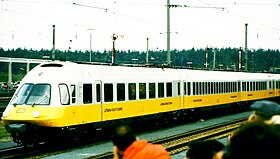DB Class 403
| DB Class 403 | |
|---|---|

DB Class 403
|
|
| Number(s) | ET 403/404 001–003 |
| Quantity | 3 |
| Manufacturer | LHB, MBB, AEG, BBC, Siemens |
| Year(s) of manufacture | 1972 |
| Retired | 1993 |
| Axle arrangement | Bo'Bo'+Bo'Bo'+Bo'Bo'+Bo'Bo' |
| Track gauge | 1,435 mm (4 ft 8 1⁄2 in) standard gauge |
| Service weight | 235.7 t (232.0 long tons; 259.8 short tons) |
| Top speed | 220 km/h (140 mph) 200 km/h (120 mph) in service |
| Power output (continuous) | 3,840 kW (5,150 hp) |
| Starting tractive effort | 200 kN (45,000 lbf) |
| Electric system | 15 kV 16 2⁄3 Hz AC Catenary |
| Collection method | Pantograph |
| No. of traction motors | 4 per waggon |
| Transmission | Quill |
| Brakes | Discs |
| Train protection | SiFa, LZB, AFB, Indusi |
| Couplers | Scharfenberg |
| Seats | 183 |
The DB Class 403 was a series of three electric multiple units commissioned by the Deutsche Bundesbahn in the 1970s, an early predecessor of the Intercity-Express as a high-speed train. The units were mainly used for InterCity services and again by the Lufthansa airline in the 1980s. Due to their distinct design of the front section, they were nicknamed "Donald Duck". They were designed for operation speeds of up to 220 km/h, a speed which was also attained in extensive test drives, but they were limited to 200 km/h in regular DB service.
After the development and introduction of the E03 highspeed-locomotive the Deutsche Bundesbahn ordered the railway industry to propose designs for an Elektro Triebwagen (highspeed electric multiple unit) capable to operate with 200 km/h on the planned InterCity network. On 24 May 1970 the Deutsche Bundesbahn decided to order three prototypes and ordered various German companies to build the trains. Linke-Hoffmann-Busch built six driving cars, designated as class 403.0, MBB built three coaches (class 404.0) and three dining cars (class 404.1). The bogies were built by MAN and the electric equipement was built by AEG, BBC and Siemens. All axles of the train were powered and the train featured a tiliting mechanism as many new developments in the early 1970s, e.g. the British Advanced Passenger Train. With the twelve cars built three prototype electric multiple units consisting of 1 drivingcar + 1 coach + 1 diningcar + 1 drivingcar were formed:
Thanks to the powered bogies on every car the train could be enlarged with extra coaches. The concept of powered bogies was applied to the InterCityExpress 3, also designated as class 403, some decades later.
The first train was handed over to DB on March 2, 1973 and trial runs were carried out between 28 November 1973 and 8 August 1974. The tilting mechanism was shut-off because it did not fulfil the expectations The revenue service started on 29 September 1974 as InterCity Riemenschneider, Nordwind, Südwind, Albrecht Dürer and Hermes on the line between Bremen and Munich. Due to the lack of suitable high-speed tracks the trains were able to reach their maximum velocity between Munich and Augsburg only. The impossibility of reacting to fluctuating passenger numbers soon made the trainsets prohibitive and impractical. They were removed from IC services in 1979 and replaced by Class 111 locomotives, when the IC '79 scheme introduced the 2nd class on previously 1st class-only IC services.
...
Wikipedia
